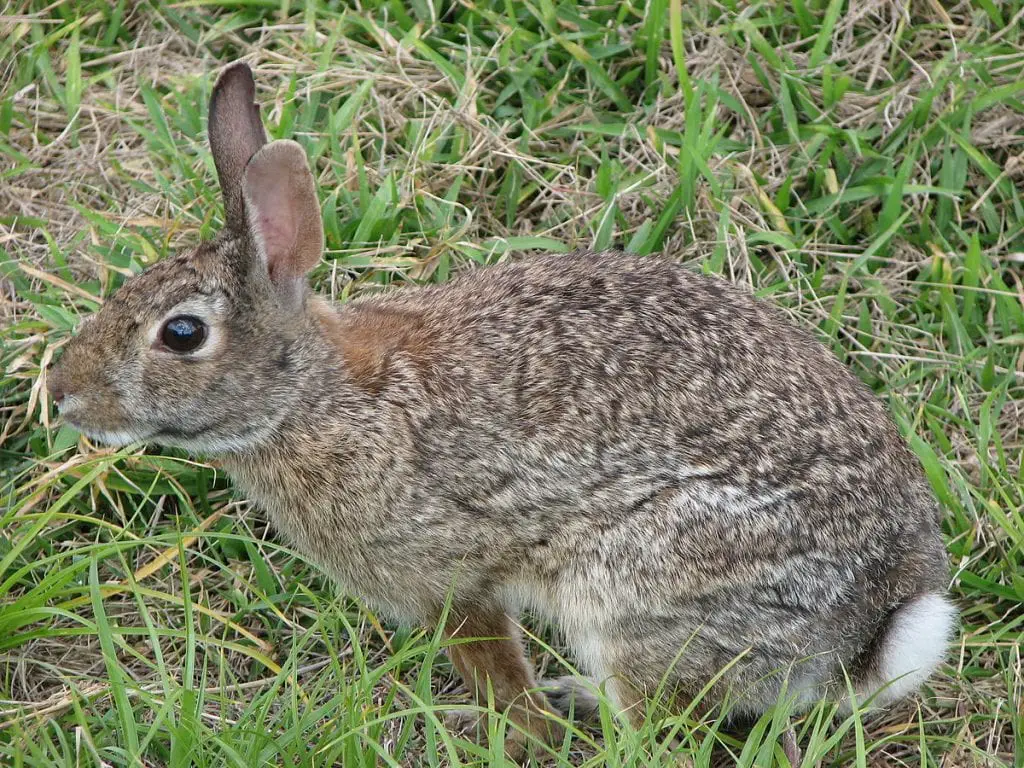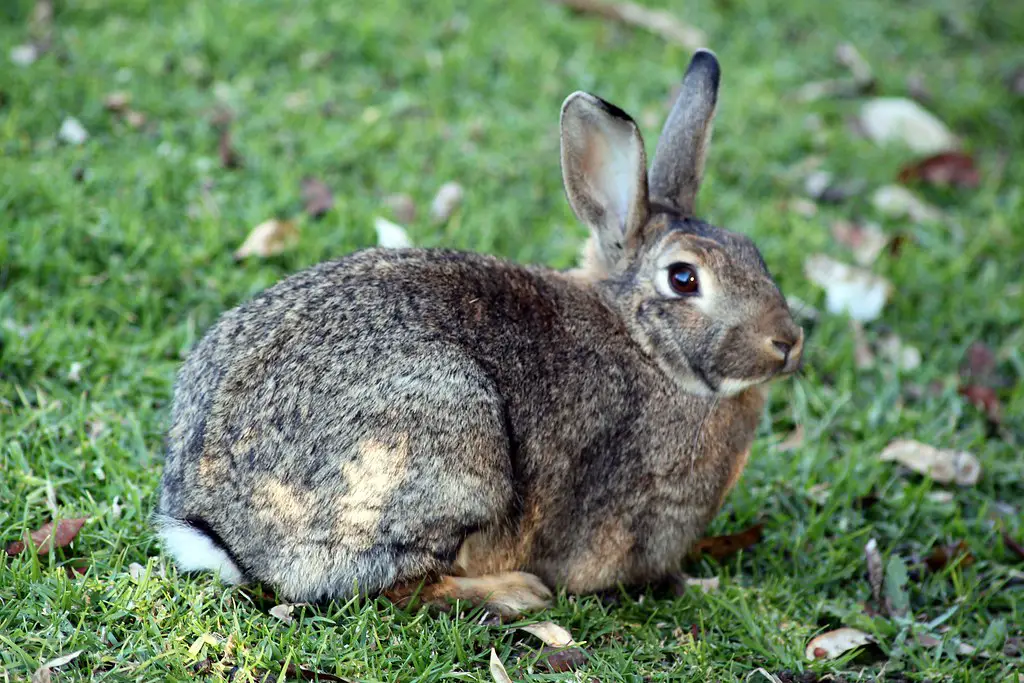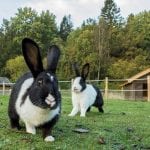Scientific Facts
| Common Name: | Bunyoro rabbit, Central African rabbit |
| Scientific Name: | Poelagus marjorita |
| Life Span: | 12 years (in captivity) |
| Size: | 17 to 20 inches |
| Habitat: | Low scrublands and grasslands |
| Country of Origin: | Uganda |
Fast Facts
| Best Suited For: | Singles and families |
| Temperament: | Docile, nocturnal, shy |
| Comparable Breeds: | African Savannah Hare, European Rabbit, and Eastern Cottonhail |
Physical Description
The Central African rabbit, commonly known as Bunyoro rabbit, is a mammal in a family Leporidae. It’s monotypic in the genus Poelagus. The Bunyoro rabbit exists in central Africa. Its common habitat is moist savannah that often comes with rocky outcrops.
A Bunyoro rabbit has a head-and-body length of around 440 up to 500 millimeters or 17 to 20 inches. It often weighs 4.4 to 6.6 pounds or 2 to 3 kilograms. Both its ears and hind legs are shorter compared to that of other rabbit species found in Africa. The coat of this species is coarser. The general color of a Bunyoro rabbit is greyish-brown. Its tail is yellow on top and white underneath.
The genitals of male and female Bunyoro rabbits are the same in appearance because of the undistinguishable sac-like glands behind their testes and curved clusters of hair covering the male scrota and happen in the same location in females. When the genital has been retracted, males and females are hard to distinguish.
Range, Distribution, and Habitat
The Bunyoro rabbit has been exclusive African species with big populations concentrated in the south of Uganda. Additionally, the Bunyoro rabbit comes with a wide distribution in west Angola and east of Sudan. Other scattered populations in Uganda exist in the north of the Lake Victoria alongside the Uganda river basin.
This rabbit is native to Central Africa. Its range expands from South Sudan and southern Chad to the northeast of the Democratic Republic of Congo and West Kenya up to the north of Lake Tanganyika. There’s another population of these rabbits in Angola.
Low scrublands and grasslands are the preferred habitats of the grass-hares. The region where the Bunyoro rabbit lives come with varying weather conditions in which there are long dry and rainy seasons occurring every year. Tall grasses grow throughout the rainy period but aren’t abundant throughout the dry season. This particular cyclic difference in the grassland production significantly affects the Bunyoro rabbit as it depends on tall grasses for sustenance and protection from the predators.
The native habitat of the Bunyoro rabbit in Uganda has been dominated by savannah-like grasslands and strewn undergrowth. The soil in this area has been rocky with crags and fissures in the ground. This particular environment seems the same for others in the Great Rift Valley. Since the region has arid conditions, the habitat of the Bunyoro rabbit is susceptible to yearly or bi-annual incidents of brush fires.
Lifespan and Longevity
The wild grass-hares often live and last for up to 4 years in the woods, though it is somewhat impossible to see older specimens in their natural habitat because of predation. The usual mortality rate for the Bunyoro rabbit takes place before or at the age of 3 and ½ years. On the other hand, a specimen that lives in captivity tends to live for up to 12 years. The life span of a Bunyoro rabbit depends a lot on proper care, diet, and husbandry.
Behavior
This rabbit is nocturnal. It hides through the day in the form of thick vegetation or the hole among the rocks and comes out to feed as part of the family cluster in the evening. The Bunyoro rabbit lives in Central Africa. This species lives in the burrows. The robust and large-headed swamp rabbit dives into the water readily. It has been known for its amazing ability to swim and dive.
The Bunyoro rabbit pays a lot of attention to its surroundings. When threatened, it will swim to keep itself safe when pursued. It can reach islets and other feeding regions. This rabbit has large and splayed toes. It moves easily on wet and muddy land. Compared to most rabbits, the male and female Bunyoro rabbits are of the same size.
Swamp rabbits construct nests made of fur and dead plants at the ground levels. Mostly nocturnal, the Bunyoro rabbit comes out of its shelter underneath the log or inside the ground hollow any time of the day after heavy rains. The animal will feed on herbs, grass, or aquatic vegetation. Also, it may forage in the grain fields where swamps can be found as well.
The Bunyoro rabbit is docile by nature. However, it tends to become aggressive when the breeding season comes in. At this time, the males compete for mates in a ferocious one-on-one battle. The male Bunyoro rabbits will fight for as long as they can and inflict severe wounds. They will keep fighting until they die.
The male Bunyoro rabbits are also protective of their territories. They secure the area through calling to trespassers and mark their regions with scent.
Communication & Perception
The same with other Lagomorphs, touch, and scent marking are crucial intra-specific ways to communicate for the Bunyoro rabbit. Whenever it sees or feels the presence of a predator, the rabbit will quickly flash the white part of its tail. It’s a way to telling the rest of the occupants that a predator is approaching. Vocalizations were not noticed in this species.
Diet
The diet of a Bunyoro rabbit is mainly comprised of grasses as well as flowering plants. The animal loves the young, succulent shoots sprouting from the land after it has been burned or cleared.
If it leaves close to a cultivated area, the rabbit will feed on peanuts and rice plants. It survives on the short grasses, forbs, shrubs, and tubers. Likewise, the Bunyoro rabbit will eat growing shoots and flowering buds. The animal may also re-ingest its stools to get the remaining nutrients they contain.
Predation
The common predators of the Bunyoro rabbit may include owls, hawks, servals, servaline genets, and cape genets. This rabbit is a crucial prey species for most raptors living in Uganda, such as hawks, owls, and eagles. Genetta servalina and Genetta tigrine are two of the most typical predators of the grass-hares though cats and baboons may also prey on the Bunyoro rabbit, too.
Reproduction
The mating process for this animal seems to be polygynandrous. Both male and female Bunyoro rabbits are having multiple mates. Induced ovulation happens to a female Bunyoro rabbit, and it becomes ready for copulation after weaning the final one in her recent litter.
A male Bunyoro rabbit will mate with different females inside of its territory. At the same time, it will be aggressive as it will chase away any other male that will try to enter its territory. Likewise, the male Bunyoro rabbit will chase a female once it chemically communicates its sexual availability. The female rabbit will accept different males to be its mating partners if they succeed in chasing it.
The Bunyoro rabbits breed across the year. The females will be encouraged to ovulate through copulation. The gestation time will take 4 to 6 weeks, and each litter will contain 1 to 2 baby bunnies. The babies are weaned between 3 to 6 weeks after birth and will eventually become independent. Juveniles, regardless of gender, will become sexually mature 3 months after they were born.
After they mate, the females will start building their nests underneath the thick undergrowth or inside the crag or cave. They will line it with grass and fur. The males will not help them in this task and even in taking care of the babies.
Leporidae often gives birth to well-developed offspring that can run a few minutes after delivery. However, this is not the case for a Bunyoro rabbit. The bunnies are born with their eyes closed. They are also weak and immovable at this period. Their eyes will open, and they will gain strength in just a few days after they were born.
The mother will feed the babies for almost 5 weeks. It may also get pregnant for the second time even before the babies are weaned.
The mother may also allow the juveniles to come and forage together at night. The female will not look after her offspring but will come back from foraging to remove the feces and feed the young.
Breeding
Breeding can take place anytime. The females will give birth to babies inside the breeding hole that has an entry path that is loosely covered with their grass or soil. Every litter may contain 1 to 6 babies, but it often comes with 2 to 3. A female Bunyoro rabbit can have as much as 2 litters every year.
Bunyoro Rabbits and Their Role in the Ecosystem
Uganda grass-hares such as the Bunyoro rabbits are like miniature-ungulates. Since their population is sensibly high in Uganda, these animals serve as a vital prey species for both aviary and cursorial predators.
The unlikely association that the Bunyoro rabbit has created is the close dependence on buffalos. The buffalos are hefty browsers as they tend to transform a tall grassland into a lower grazing field. It is the best suitable kind of habitat for a Bunyoro rabbit. Thus, it is not unusual to see tiny groups of these rabbits browsing together with these giant bovids.
The Positive and Negative Economic Significance of the Bunyoro Rabbits for Humans
These rabbits aren’t known to be economically important to people. Also, there were no reports involving these Bunyoro rabbits affecting adversely the humans.
Conservation Status
The rising agricultural expansion in Uganda affects the scrublands and grasslands where the Bunyoro rabbit lives. It seems to be a reason if the population of Bunyoro rabbits declines in the next few years. Also, the continuous rise of human populations may even harm the populations of various species of rabbits, including the Bunyoro rabbit.
However, the population of Bunyoro rabbits seems to be stable. The species is widely common in some portions of their range. No specific threats were noticed, but the animal has been hunted locally. For all these things, the IUCN listed the Bunyoro rabbit under the Least Concern category in the red list of endangered species.

Availability – Where to Get One
If you want to keep a Bunyoro rabbit, then you may try searching for this species in the pet stores and breeders online.
Cost
Taking care of a Bunyoro rabbit does not sound too demanding and pricey. Your pet will need housing that is wide enough for itself, a stable supply of healthy food, toys, and water. You don’t have to worry about the lighting, heating, and cooling conditions of your home. Therefore, you may end up spending more or less $100 a month for your Bunyoro rabbit.
At first, you may spend more than that as you need to purchase the following materials for your pet:
- Wire covers
- Indoor housing
- Baseboard or furniture protection
- Baby gates or puppy pens
- Litter box
- Water and food dishes
- Rabbit-safe litter
- Hay feeder
- Chair mat (optional)
- Cardboard box
- Nail clippers
- Chew toys
Health Concerns
Like other rabbits, the Bunyoro rabbit is prone to different health problems. These include:
- Infectious conditions like rabbitpox, papillomatosis, rotaviral infections, and myxomatosis
- Thick pus
- Snuffles
- Pasteurella
- Enteritis
- Bloating
- Teeth malocclusion
How to Care for a Bunyoro Rabbit as a Pet
Rabbits are fun-loving, unique pets. They come with specific needs that you need to fulfill for them to live a happy, long, and healthy life. Here are some tips that can help you take good care of your Bunyoro rabbit:
- Install safe housing indoors.
- Make your house bunny-proof.
- Feed it with fresh hay, fresh greens, and pellets. Don’t forget to provide it with fresh water.
- Set up a small litter box.
- Give it proper enrichment.
- Groom your pet regularly.
- Take your pet to a veterinarian whenever it seems sick, or you notice any health-related issue.
- Understand your pet’s behavior and language.
Housing
Rabbits are crepuscular. Meaning, they sleep throughout the day and at night, but they are ready for fun and play at twilight and dawn. Make sure you let your pet go out of the cage at night when you’re at home. If possible, do it as well in the morning before you go for work.
Whenever you are not around, and nobody else is at home, you will just prefer to keep your Bunyoro rabbit in the cage to ensure its safety. However, if you think your pet is already familiar with the house, and your house is already bunny-proof, there’s no reason for keeping it inside the cage and not allow it to run and play on its own while you are not there.
A bigger cage is better. The housing of your Bunyoro rabbit must be at least 4 to 6 times bigger than the size of your pet when it’s completely stretched out. The animal will require a much bigger cage if you often keep it confined for the most part of the day.
When you choose the right size of enclosure for a Bunyoro rabbit, always take note of the amount of exercise space and the time your pet has. A big enclosure that will allow your pet to hop and run inside will be enough. You can even purchase or make a personalized 2-story house with floors attached by a ramp. Your pet will love it for sure.
Grooming
The Bunyoro rabbit is a fastidious groomer. It needs brushing that should be done every week. Aside from removing loose hair, the weekly brushing sessions will help your pet prepare itself for multiple everyday brushings that it needs to undergo when heavy shedding occurs. Your pet will shed in many ways.
Fun Facts About Bunyoro Rabbits
- The scientific name of the Bunyoro rabbit is Poelagus marjorita.
- The Bunyoro rabbit does not stick to one mating partner in every breeding season. Instead, both males and females will try to gather more partners. Males will run after females that show up available for mating. Then, females will accept them as mating partners only when males succeed in running after them.
- The Bunyoro rabbit is native to Uganda.
- Both male and female Bunyoro rabbits share the same physical characteristics and features. Therefore, it is extremely difficult to recognize their gender, even based on their genitals.
FAQs
How long does the Bunyoro rabbit grow?
This rabbit is one of the famous African rabbits. It measures 17 to 20 inches in most cases.
What is the average lifespan of a Bunyoro rabbit?
A Bunyoro rabbit tends to have a longer lifespan when kept in captivity. In the wild, this rabbit often dies at an early age due to loss of habitat and predation.
What is the coloration of a Bunyoro rabbit?
In general, the Bunyoro rabbit is greyish brown from head to feet. Its tail is yellow on top while the underneath is white.
Is the Bunyoro rabbit aggressive?
The Bunyoro rabbit is calm by nature. However, it becomes hostile when the breeding period comes in.


